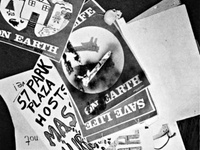In the spring of 1983, Cambridge became the battleground for a showdown between defense contractors and anti-nuclear groups. A grassroots movement spearheaded by voter mobilization group Nuclear Free Cambridge attracted national attention when members began to voice strong opposition to nuclear weapons research and development in the City.
They succeed in putting the issue to a vote in ballot referendum—which voters ultimately rejected in a close vote—that specifically called for the prohibition of various activities related to local production and use
of nuclear weapons and was proposed to take effect on Oct. 1, 1985. Those who rallied behind the referendum claimed that the city would not be completely nuclear-free even if it were to pass, however. Major exemptions to the law would have included nuclear medicinal research and any other nuclear research not intended primarily for the development of weaponry.
LEGAL STRUGGLE
In campaigning for the referendum, advocates encountered a legal barrier: they needed to muster 4,000 signatures to give Cambridge voters an opportunity to vote for or against the measure on the November ballot.
In addition, the Cambridge City Council attempted more than once to keep the question off the ballot due to opposition from special interest groups.
During a series of heated council hearings, opponents of the referendum testified against
its legality and threatened to bring the issue to a higher court if it were to pass.Two major concerns were the possibility
that the measure would violate researchers’ and developers’ First Amendment rights and that it would overrule a preexisting federal measure that approved nuclear weapons research and development.
The referendum was met with criticism from
groups that it would have affected most, including the management consulting firm Arthur D. Little, American Scientific and Engineering, and Cambridge’s largest defense contracting firm, Charles Stark Draper Labs, which was conducting design work on nuclear weapons at the time. The vice president of Draper Labs,
Joseph O’Conner, claimed that its passage could force the company to shut down and prevent new high-tech companies from moving to Cambridge.
“We’re working on programs that have been approved by Congress and the question is whether any local community can take actions that are contrary to what Congress is doing in this area,” O’Conner said in a 1983 interview with The Crimson.
By the time the controversial referendum had
gained momentum, there were already 10 nuclear free zones in the United States.
However, Cambridge had played a leading role in the nuclear freeze movement even before the referendum—it was one of the first cities in the country to support a moratorium on nuclear weapons production through a non-binding referendum in 1981.
NUCLEAR FREE HARVARD
Many Harvard students who opposed nuclear proliferation openly expressed their discontent.
According to then president of the Graduate School of Education’s Student Association Cabinet John B. Chittick, many Harvard students were vocal about their feelings towards nuclear proliferation. “It was a very big item because
[the United States was] still very much involved in the Cold War,” Chittick said.
A large proportion of Harvard students and other Cambridge residents actively supported the referendum due not only to their disapproval of nuclear proliferation, but also to their general tendency to go against the grain.
“My impression was that students at Harvard, speaking generally, that students like the idea of Cambridge being out of step with other cities in the country and Harvard being different from other schools,” Chittick said, adding that “Cambridge was very much against anything that Ronald Reagan stood for.”
Students had advocated against the nuclear
arms race even prior to the referendum. The Harvard Council of Student Leaders, a coalition
of University student government representatives, had launched a campaign to convince graduating Harvard students to wear green armbands at Commencement in protest of nuclear proliferation.
BLITZ CAMPAIGN
“[The nuclear weapons researchers and producers] were scared and brought out the big bucks and guns to fight this; they had really deceptive ads with scientists behind bars,” said Grace C. Ross ’83. Ross, who worked on the Nuclear Free Cambridge campaign, said that they had calculated at the time that the defense industry had spent 27 dollars per vote to rally citizens against the ban.
“It was Cold War language,” Ross said, “They did their best to try to play on people’s fears that if this passed the Soviet Union would take over Cambridge or something.”
However, the proposed measure was ultimately defeated in November of 1983 by an aggressive publicity campaign launched by its opponents, most notably the national organization Citizens Against Research Bans.
Criticism resurfaced once an expenditure report
was discovered. The report showed that approximately 98 percent of campaign donations to CARB came from out-of-state corporate interests that strongly advocated against the referendum.
“What was fascinating is that we were a really grassroots campaign and they had money for advertising, the money they got was from defense industries, and they timed it so that
their contributions did not have to be reported until after they blitzed the city with ads,” said James K. Hammerman ’83—’84, who worked with Boston Mobilization for Survival to pass
the legislation.
—Crimson staff writer Jillian K. Kushner contributed to the reporting of this story.
—Crimson Staff Writer Marianna N. Tishchenko can be reached at mtishch@fas.harvard.edu.
Multimedia
Read more in News
Marathon Racers Run for Charity














